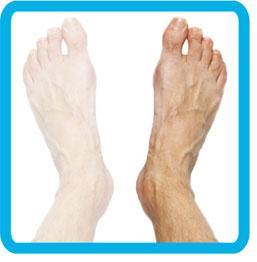
Phantom limb pain is a condition where pain is appearing to come from an area where an amputated limb used to be. This pain is often excruciating and has been described in various ways such as “burning, aching, or ‘as if the limb was being crushed in a vice”.
In 2008, an exploratory pilot study was published in the Journal of Complementary Therapies in Clinical Practice.
It was a 30 week study with 7 men and 3 women all having lower limb amputations and a history of phantom limb pain. There were five phases to the study, which also involved teaching the techniques to the participants of the study.
The result: “Each reflexology treatment made a highly significant difference and was effective in eradicating or reducing the intensity and duration of phantom limb pain.”
Now long before the study was even thought about – I was practicing Reflexology in my private practice in London, England in the 1980’s. One day I received a call to see if I could help a young man whose left leg was amputated just below the knee. For the purpose of this story I will call him Mike.
His story was incredibly touching – he was an athlete out for a fun weekend ride on his motorbike – when he lost control of the bike and crashed. Mike was thrown off the bike, suffering extensive injuries to both his legs. The doctors were able to save one leg only.
Mike went through a series of operations and could not believe that such an accident could have robbed him of his dreams of being an Olympic gold medal athlete.
His family had tried everything they could to help him to no avail. Then, somebody suggested Reflexology, they don’t remember who, but they decided to have one last try, and so I was called in to help. It was now several years since his accident, and over time he had become seriously depressed. When I got to see him he was actually on a suicide watch.
On my first appointment with him, I tried the method that is often taught in Reflexology schools, of working on his remaining right foot, and then working on the hand on the left side where his foot had been amputated. After a couple of treatments, Mike reported no difference.
So I decided to change my plan and try something radical. I decided that I would apply Reflexology to his phantom foot.
After all his brain still believed that the foot was there and so did the nerves as they were sending pain signals to his brain – so I thought – why couldn’t I also work on the phantom foot nerves and see if we couldn’t send a different signal to the brain.
I must confess that I felt very silly, when I told Mike of my plan. I remember that he just lay there with an empty stare and gave a small nod in agreement.
Traditionally when I work with Reflexology I start on the right foot, so I completed my usual routine on the right foot, and I literally called out all the areas of the foot that I was working on. Then I moved over to the left foot – the one that was no longer there – the one that was giving Mike so much pain.
I again called out all the areas of the foot as I worked them, the big toe, second toe, third toe, etc… the ball of the foot, the centre of the foot, the top of the foot, the heel, the instep and so on.
As I said I felt very foolish doing this, but I have learnt over the years, that nothing ventured, nothing gained. I completed the foot by giving some gentle strokes, and at the end of the session, gently rested my hands on his real right foot and phantom left foot. I waited for a couple of minutes and then asked how he was feeling.
A look of surprise crept over his face as he looked down at his foot. He said he could feel nothing – puzzled I asked what that meant – was that a good or bad sign – he said I can feel no pain in my leg – in my phantom leg – for the first time in years, I can feel no pain there.
I can’t tell you how I felt at that moment… we were both emotional – anyway I visited him a few more times, and he reported that the pain did not return.
I heard later that he had taken up para Olympic sports and hoped to realise his ambition of winning a gold medal quite soon. It is stories like this that make me passionate about Reflexology.

As an amputee myself, and a practiced Reiki Master, I’ve often wondered how Reflexology would help with amputees. Reiki worked for me after surgery when my body was still registering the presence of my left leg. Visualization and passing of energy is a powerful thing with or without limbs. I’ve witnessed as practitioner and receiver in Reiki, so why not Reflexology? How interesting this is! I wondered if someone without limbs would have reflexology done at the end of what’s left of their limb. It seems, though, that the engagement of energy work and visualization was a powerful means to make it work. So glad it did!
Thanks for your comments Monica,
You might also be interested in the Kirlian Photography video – that is under the video link at the top of this page. It is called Photographing Energy – here is a link
Photographing Energy
Have you seen the scientific video showing reiki energy?
Lauren
I have, yes! Again, fascinating stuff.
Monica
hi there i found your story of the reflexology treatment on the amputated foot really interesting, my dad had recently had his left leg amputated and is having phantom pains. i dont do reflexology i once started the course but i didnt finish it, what a silly girl i was. i will look into doing a course immediately and will finish it for sure. this story has really inspired me, i thank God for directing me to your web page. Serena x
Hi Serena,
This is just one of many success stories relating to phantom limb pain. I absolutely urge you to look into getting Reflexologyfor your Dad. Absolutely nothing to lose and everything to gain.
Take a look at our easy online course – http://www.LearnFootReflexologyOnline.com
If you have any questions – just ask 🙂
Lauren
I have a client who is an amputee lost leg below the knee about 4 years ago and he wants me to work on the stump rather than on the hand, I have been doing both (belt and braces) do you have any advice about working on the stump? clearly it will help his circulation in that area and I am not adverse to doing it just not sure how beneficial it is for him from a reflexology point of view
any advice ?
Hi Louise,
Thanks for your great question. Here’s my 2 cent worth!!
I have worked the hand on the same side as the foot that has been lost – did not work – have worked the stump – did not work – worked the actual phantom foot area – worked!
To me the key is to talk through the session- I am working the big toe – five stripes one for each zone – and mentioned each zone number as I worked it – working the pituitary reflex etc… Be sure to use the word reflex after each reflex point you work, instead of just sayiang pituitary – this helps to reinforce to the client that we are working on a different level than the physical.
Intention goes a HUGE way into creating the right environment for healing to happen, and if you are working both the stump and phantom foot area, and perhaps also the hand – the intention is clear that you don’t trust just one method to “do” the job.
Therefore your intention is unclear and so is the actual outcome of the session.
Do you use Reiki or any other form of energy healing in your practice? In cases like this I have found it helpful to carry out a distant healing prior to the physical session and send that forward in time.
I also use muscle testing and dowsing to find out what is actually happening in the body.
Hope this helps – I would be interested to hear how you get on.
Lauren
Hi
I am a reflexologist and I just received a message from a client to tell me she had her foot amputated last week. I treated her regularly last year for ulcer problems, diabetes, heart condition etc, but had not seen her recently. I have not treated a client before with an amputation but she has requested to see me again. I felt I needed to know more and you have really inspired and confirmed my gut thoughts about treating the amputated limb even though it is now gone. Thankyou Nina
Hi Nina,
What a pity your client did not come to you before the amputation. What makes Reflexology such an incredible healing art, is that we get fabulous results, even after our clients have been “through the mill” with conventional medicine. Now if only we could get to them sooner, just think what we could achieve!
Will you let me know how the session goes?
Lauren
Lauren, I read the article on phantom limb pain. This was a very inspiring story. With all the soldiers coming back tfrom war and losing their limbs and just accidents in general where people lost limbs, I thought it would be in the best interest to also learn hand reflexology, which I still want to do, but doing the reflexology on the foot that is no longer there physically was very interesting. Being how his nervous system still thought it was there, your intuition paid off for this person.
Hi,
I am a nurse, Reflexologist and Reiki practitioner. I have been working with a Palliative client with a Below R Knee Amputation. I work her stump as I would have her foot. Mapping out the reflexes in my mind as if her foot was there. Initially nothing significant was changing but after the 3rd Treatment I was starting to pick up imbalances that I would further work on. Overall the client has a greater feeling of well being. The combination of the energy work from Reiki and the focus and intention when giving the Reflexology has proved invaluable.